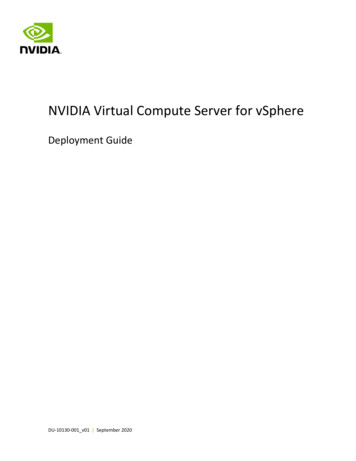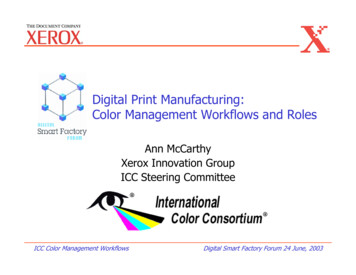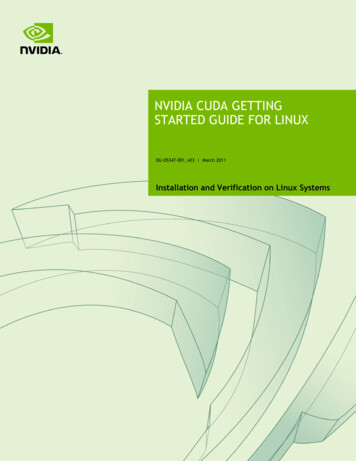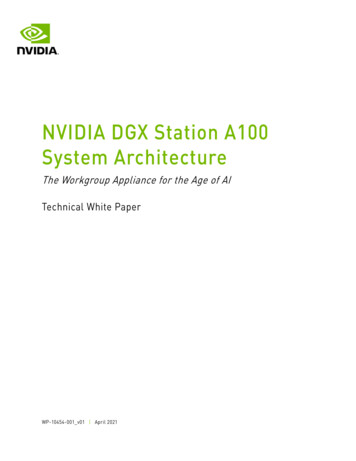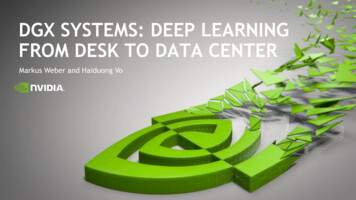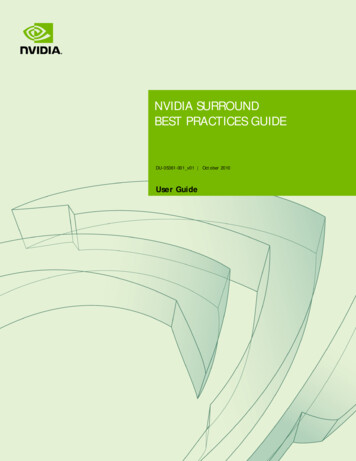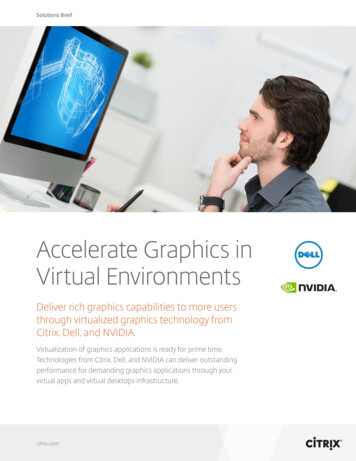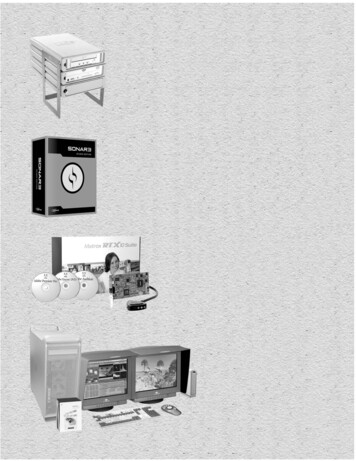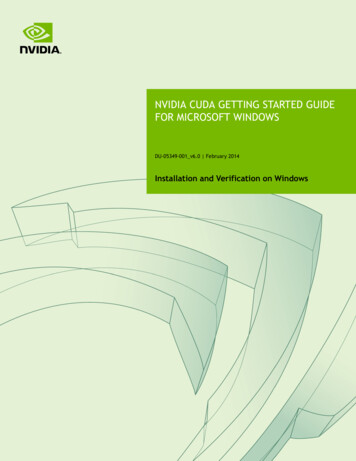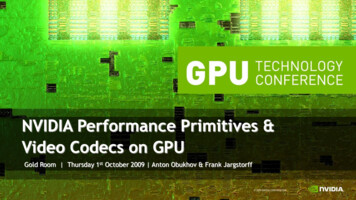
Transcription
NVIDIA Performance Primitives &Video Codecs on GPUGold Room Thursday 1st October 2009 Anton Obukhov & Frank Jargstorff
Overview Two presentations:– NPP (Frank Jargstorff)– Video Codes on NVIDIA GPUs (Anton Obukhov) NPP Overview– NPP Goals– How to use NPP?– What is in NPP?– Performance
What is NPP? C Library of functions (primitives) running on CUDA architecture API identical to IPP (Intel Integrated Performance Primitives) Speedups up to 32x over IPP Free distribution– binary packages for Windows and Linux (32- and 64 bit), Mac OS X Release Candidate 1.0: Available to Registered Developers now.– Final release in two weeks at http://www.nvidia.com/npp
NPP’s Goals Ease of use– no knowledge of GPU architecture required– integrates well with existing projects work well if added into existing projects work well in conjunction with other libraries Runs on CUDA Architecture GPUs High Performance– relieve developers from optimization burden Algorithmic Building Blocks (Primitives)– recombine to solve wide range of problems
Ease of Use Implements Intel’s IPP API verbatim– IPP widely used in high-performance software development– well designed API Uses CUDA “runtime API”– device memory is handled via simple C-style pointers– pointers in the NPP API are device pointers– but: host and device memory management left to user (for performance reasons) Pointer based API– pointers facilitate interoperability with existing code (C for CUDA) and libraries (cuFFT,cuBLAS, etc.)– imposes no “framework” on developers
Example// allocate source imageint sp;Ipp8u * pSI ippiMalloc 8u C1(w, h, &sp);// fill with some image contenttestPattern 8u C1(pSI, sp, w, h);// allocated destination imageint dp;Ipp8u * pDI ippiMalloc 8u C1(w, h, &dp);// Filter mask and achorIppiSize mask {5, 5};IppiPoint anchor {0, 0};IppiSize ROI {w - mask.width 1,h - mask.height 1};// run box filterippiFilterBox 8u C1R(pSI, sp, pDI, dp,ROI, mask, anchor);// allocate host source imageint hp;Ipp8u * pHI ippiMalloc 8u C1(w, h, &hp);// fill with some image contenttestPattern 8u C1(pHI, hp, w, h);// allocated device source imageint sp;Npp8u * pSI nppiMalloc 8u C1(w, h, &sp);// copy test image up to devicecudaMemcpy2D(pSI, sp, pHI, hp, w, h,cudaMemcpyHostToDevice);// allocate device result imageint dp;Npp8u * pDI nppiMalloc 8u C1(w, h, &dp);// Filter mask and achorNppiSize mask {5, 5};NppiPoint anchor {0, 0};NppiSize ROI {w - mask.width 1,h - mask.height 1};// run box filternppiFilterBox 8u C1R(pSI, sp, pDI, dp,ROI, mask, anchor);
What is in NPP? Only Image-Processing Functions– subset of “IPPI” library– 300 functions Limited set of data-types supported– 8-bit per channel: 8u C1, 8u C4, 8u AC4– high bit depth: 32s C1, 32f C1 Conversion functions to and from most otherIPPI formats
What is in NPP? Data exchange & initialization– Set, Convert, CopyConstBorder, Copy,Transpose, SwapChannels Arithmetic & Logical Ops– Add, Sub, Mul, Div, AbsDiff Threshold & Compare Ops– Threshold, Compare Color Conversion– RGB To YCbCr (& vice versa), ColorTwist,LUT Linear JPEG– DCTQuantInv/Fwd, QuantizationTable Filter Functions– FilterBox, Row, Column, Max, Min, Dilate,Erode, SumWindowColumn/Row Geometry Transforms– Resize , Mirror, WarpAffine/Back/Quad,WarpPerspective/Back/Quad Statistics– Mean, StdDev, NormDiff, MinMax,Histogram, SqrIntegral, RectStdDev Computer Vision– Canny Edge Detector
Performance Relative performance compared to IPP– Measuring methodology? Scalability– Problem size– Number of processor cores Some aggregated numbers– Performance suite averages
Performance Measuring Methodology Each primitive under test:– Is executed 25 times– Each iteration uses same data and same parameters– Data for GPU primitives is already on GPU (i.e. transfer times are not included intimings) All performance data gathered with single test application– test 2800 performance tests– most performance tests are simply repurposed functional tests testing offset and oddly sized ROIs testing various parameters performance tests usually run at 720p and 2k x 2k image sizes
Scalability with Problem Size (1) Primtive: ippi/nppiAbsDiff 32f C1R– computes per pixel absolute difference of two single-channel float imageand stores result in third image– performance scales linearly with problem size– Time Plots: Lower is Better!Linear Algorithm Expected Results201510– 0 OCPU OGPU5– SCPU SGPU 01 Where’s the cross over point?CPUGPUProblem size19161310704Time– linear with offsets OCPU & OGPUand slopes SCPU & SGPU25
Scalability with Problem Size (2) Size from 1024x4 (16kB) to 1024x204 ( 800kB) Offset & Slope:AbsDiff 32f C1R0.07– CPU: O 0 µs, S 25 µs/100 lines0.06– GPU: O 15 µs, S 10 µs/100 lines– CPU slow:0.05Nehalem1 Thread0.04Time [ms] Crossover:Intel Core i7 Extreme Edition i7-9653.2 GHz, 4 (8) Core, 8MB Level 3 Cache 48 lines 48kPixel (4Byte) 192kB– CPU fast: 108 line 108kPixel (4Byte) 432kB– Compare: 720p: 1280 x 720 900kPixelGTX 2850.030.020.010Lines in Image (1024 x N)
Scalability with Problem Size (3) Going in size up to 4096 linesAbsDiff 32f C1R GPU scales linearly2.52 Asymptotically CPU 7.5x GPU– 1000 lines 4MByte image– 8MB level 3 cache sizeNehalem1 Thread1GeforceGTX 42344252427042884306432443424360437843964– Between 1000 and 3000 linesTime [ms] CPU: Slope transition1.5Lines in Image (1024 x N)
Scalability With Number of Cores (1) For GPU not easy to control number of cores used. Compare two different GPUs/Graphics Cards:– Geforce 9800 GTX : 16 SMs, 738MHz 11808nppiAbsDiff 32f C1R– Geforce GTX 285: 30 SMs, 648MHz 194400.6– 19440/11808 1.640.5– GTX 285: 260µs– 4.8/2.6 1.84 GPU scales linearly with numberof SMs (cores) across full rangeof problem sizes.0.3GeforceGTX 02596281230283244346036763892– 9800 GTX: 480µs0.4Time [ms] Chart at max size:Geforce9800 GTX Lines in Image (1024 x N)
Scalability With Number of Cores (2) Use ippSetNumThreads(int n); to control number of coresused.ippiAbsDiff 32f C1R Expected Result:0.061 Core0.052 CoresTime [ms]0.044 Cores0.038 Cores0.020.01042036526884100 116 132 148 164 180 196Lines in Image (1024 x N)
Scalability With Number of Cores (3) CPU performance does not scale with number of cores, evenfor small problem sizes.ippiAbsDiff 32f C1R: Intel Core i7 Extreme Actual Result:0.090.081 Core0.07Time [ms]0.060.052 Cores0.040.034 Cores0.020.018 Cores042036526884100 116 132 148 164 180 196Lines in Image (1024 x N)
Scalability With Number of Cores (4)ippiAbsDiff 32f C1RNehalem1 Thread2.5 Full range ofimage sizes onCPUNehalem2 Threads1.51Nehalem4 8203076333235883844Time [ms]2Lines in Image (1024 x N)– Not clear howmany threads are the best configuration for max performance. CPU does not scale with number of Cores.Nehalem8 Threads
Aggregate Performance Numbers (1) Average over 2800performance tests.– performance tests arerepurposed functional tests– run on 720p and 2k x 2kframes (mostly)1210.6577165610Relative Agregate Speed– each test gathers IPP andNPP processing timesNPP Performance Suite Grand Totals86.02803907264211.020285405Core2Duo t 1Core2Duo t 21.8325008232.023517787Nehalem t 1Nehalem t 80ProcessorGeforce 9800GTX Geforce GTX285
Aggregate Performance Numbers (2) Put into perspective:– NPP is 1.0 release– has been developed in 6 months* Exception: some statistics functionsuse atomics from compute capability1.1.– no processor specific optimizations* all code compiled for compute 1.0 or 1.1– for the most part only optimized for memory coalescing Intel Core i7 vs. GTX 285– really different generations (GTX 285 uses 1.5 year old arch) That means there’s still a lot of room for improvement.
Summary NPP– easy to integrate– provides substantial performance gains over highly optimized x86 code– 300 functions GPU/NPP Performance– scales extremely well with problem sizes and GPU type– room for performance improvements– particularly well suited for larger image sizes For questions regarding NPP please contact:– npp@nvidia.com
Video Codecs on GPUFairmont Hotel, San Jose 10.01.2009 Anton Obukhov
Motivation for the talkVideo encoding and decoding tasks requirespeedups as never before:Encoding hi-res movie takes tensof hours on modern desktopsPortable and mobile deviceshave unveiled processing power
Video capabilities evolutionWithout PureVideo HDBitstreamProcessingCAVLC CABACHigh CPU ockingReduced CPU UtilizationGeforce 7 SeriesBitstreamProcessingCAVLC Minimal CPU UtilizationGeforce 8 SeriesBitstreamProcessingCAVLC CABACInverseTransformMotionCompenstationDeblocking
Video encoding with NVIDIA GPUFacilities: SW H.264 codec designed for CUDA– Baseline profile– Main profile– High profileInterfaces: C library (NVCUVENC) Direct Show API Win7 MFT
Video decoding with NVIDIA GPUFacilities: HW GPU acceleration of– H.264– VC1– MPEG2 SW MPEG2 decoder designed for CUDAInterfaces: C library (NVCUVID), HW & SW DXVA and Win7 MFT, HW only VDPAU library, HW only
Video processing with NVIDIA GPUFacilities: SW pre- and post-processing library designed for CUDA– Noise Reduction– Deinterlacing– Polyphase Scaling– Color Processing– Deblocking– Detail enhanceInterfaces: VMR/EVR API
Benefits of Decoding with GPU 100% Offload of 3 Major Video CODECsWithoutNVIDIA stationHigh CPU UtilizationMinimal CPU Utilization
Encode performanceCPU EncodeGPU Encode60.00frames per bedtractorsunflower1080i2997 stockholm ter 1080i2997 mobcal terFrame size: 1080pPlatform: 3.2 GHz quad core Nehalem, GeForce GTX 280 (240 core) GPUCPU encoder is x264GPU encoder is NVIDIA H.264 CUDA encoder.pedestrian area
Video encoding with NVIDIA GPUCommercial applications for video transcodingwith CUDA Badaboom Nero Move it CyberLink PowerDirector Loilo SuperLoiloscope Tons of them!
Thoughts aloud What aboutand? What about multi-GPU systems?
Thoughts aloud What aboutand?– Linux: only decoding acceleration with VDPAU– Mac OSX: QuickTime API
Thoughts aloud What about multi-GPU systems?– NVIDIA H.264 encoder is going to support dual-GPUsystems
Thoughts aloud Multi-GPU systems arecommodity Programming for MultiGPU systems ischallenging
Thoughts aloudCUDA provides access toevery GPU. How to makethem all work efficiently?NKjobsGPU 0GPU 1Work (N jobs)GPU K-1
Thoughts aloudThere is a need for an open-source video codecsthat can accelerate the transcoding pipeline usingGPUsWebinar 10/28/2009 9:00 AM - 11:00 AM PDT Multi-GPU techniques Application for video 827
Questions & Answers?E-mail: aobukhov@nvidia.com“Introducing a new Multi-GPU framework” webinar, 10/28/2009 9:00 AM - 11:00 AM PDThttps://www2.gotomeeting.com/register/628549827
- device memory is handled via simple C-style pointers - pointers in the NPP API are device pointers - but: host and device memory management left to user (for performance reasons) Pointer based API - pointers facilitate interoperability with existing code (C for CUDA) and libraries (cuFFT, cuBLAS, etc.)
